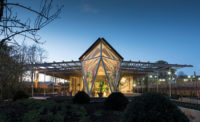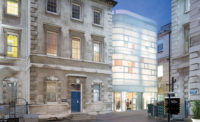County Antrim, Northern Ireland
Mass Tourism has a paradoxical effect: The infrastructure for access and interpretation it demands can obscure the very thing visitors come to see. Wilderness is mediated and culture commodified. Tour buses block the postcard view.
Sightseers have flocked to the Giant's Causeway on the coast of Northern Ireland since the 19th century, and today half a million people a year travel to this craggy formation of volcanic basalt columns lining a string of steep-sided bays. For the last 12 years they have been greeted by a dreary range of timber sheds, installed after a permanent visitor center was destroyed by fire. In 2005 the government organized an international design competition for a replacement befitting a UNESCO World Heritage site. The newly complete $30 million building, by Dublin-based Heneghan Peng, is exemplary in its balance of competing demands, making space for commercial and transport requirements while recognizing that these should not intrude on visitors' experience of the place.
Many competition entrants exploited the prominence of the cliff-top site above the western end of the causeway, proposing flamboyant structures that would dominate views from inland as well as from the water's edge. Heneghan Peng took a different approach, folding its building into a remade landscape in a careful choreography of concealment and revelation.
From the shore the center is essentially invisible; it fills a gap in the existing ridgeline, but is screened by man-made berms that read as part of the natural landscape. From cliff-top trails, too, the accessible grass roof hides the building below. To the south, however, architecture emerges from the manipulated topography. 'It was important not to bury the building'that seems too easy'but to work with both the building and landscape form,' says architect R'is'n Heneghan, who runs the office with husband and former Harvard GSD classmate Shih-Fu Peng.
Approaching the center from the nearest town, Bushmills, the road brings visitors to the foot of a green ramp leading up to the ridge. To the west, the main body of the 19,375-square-foot building pushes upward as if subject to the same eruptive force as the stones of the causeway. Its two principal facades, composed of close-spaced rows of sharp-angled black basalt columns, taper off into the distance. The first diminishes as the ramp alongside it ascends to meet the ridge, while the roofline of the second drops gradually until it meets the ground next to an existing hotel to the west.
East of the grassy slope, the building's angular volume is echoed by a void'the negative to its positive'where the ground has been excavated to make a parking lot, crisply defined by the center's columnar facade and a smooth basalt retaining wall.
The stone is beautifully reflective of the ever-changing weather, shining like a mirror in sunlight and jet black in the rain. The choice and deployment of material make a direct, almost literal reference to the causeway, but the apparent simplicity of the idea belies the complexity of its execution. Basalt cannot be cut thin enough for cladding, so the 208 columns are formed from over 14,000 stacked stone blocks, in a variety of shapes and sizes, that fit together with extraordinary precision'a tribute to the architects' digital model and the stonemason's craft.
Visitors can choose from three routes to the head of the causeway trail: over the ramp, via a tunnel from the parking lot, or'for those willing to pay'through the visitor center. The interior arrangement underscores the sense that the center is a 'passage' through the ridge, not the final destination: From the entrance portico at the southern corner, a bright splash of daylight at the back of the cavernous room draws the eye along a broad promenade toward the exit.
To the left, the main components of the program'a caf', gift shop, and exhibition area'jostle uncomfortably in the single volume. A more emphatic partitioning of the space envisaged by the competition scheme was dropped to increase flexibility, and retail now dominates. Nevertheless, the room's fundamental quality remains evident: Daylight spills in from high windows and lofty skylights, and the finely detailed folded concrete roof and steel-plate columns lend elegance to material robustness. The stepped section of the basalt-flecked polished concrete floor presages the fractured pavement of the causeway.
There is not a right angle anywhere. Heneghan Peng established four axes through the site as an organizing principle, and the logic of this somewhat arbitrary grid is followed with maniacal consistency'from the massing of the terrain and placement of the structure to the shapes of trash cans and ticket machines. This discipline might have produced sterile or incommodious spaces, but the imagination and effort with which the concept has been translated into built fabric gives the whole project a rich internal coherence and another connection to the causeway, whose polygonal stones hint at the variety within nature's underlying geometric order. This is truly a building in and of its place.
Chris Foges is the editor of the London-based journal Architecture Today.
Completion Date: May 2012
Size: 19,375 square feet
Cost: $17.7 million
PeopleOwner: The National Trust
Architect:
Personnel in architect's firm who should receive special credit:
Competition
Project Design & Construction Stages
Engineer(s): M+E: Bennett Robertson Design Façade: Dewhurst Macfarlane
Consultant(s):
Building Services:
QS|PM:
Facade Engineering:
Planning:
Civils:
Landscape:
Exhibition Design:
Accessibility: Lighting: Bartenbach LichtLabor Acoustical: FR Mark General contractor: Gilbert Ash Photographer(s): Marie-Louise Halpenny & Huft+Crow as per file name Renderer(s): Archimation CAD system, project management, or other software used: AutoCAD |
Products
Structural system Manufacturer of any structural components unique to this project: Bespoke design of steel columns; 7 no. 30mm plates bolted together (custom)
Exterior cladding Bead blasted stainless steel handrails with stainless steel cable mesh infill (custom)
Roofing
Built-up roofing: Grass roof (grown using a mixture of locally collected seed and amenity grass)
Glazing Entrance Screens: Stainless steel curtain wall glazed screens (custom) Skylights: Glazed rooflights with stainless steel frame (custom)
Doors (custom) Metal doors: Anodised Aluminiumbonded to Shueco Doors or Bead Blasted Steel Wood doors: Oak Sliding doors:Glazed by Besam Revolving door:By Boon Edam
Hardware Closers: Dorma Exit devices:Dorma
Interior finishes Paints and stains:Clear lacquer Wall coverings:Anodised aluminium acoustic wall panels in main space by Durlum Germany WC Wall coverings: Terrazzo (custom) Floor: Basalt chip in polished concrete screed (custom)
Furnishings Reception furniture: Bespoke aluminium clad counter(custom) Tables: Bespoke oak(custom)
Lighting Exterior: Bespoke LED fittings to facade by Durlum Germany Dimming System or other lighting controls: Dali system for exhibition lights
Plumbing
Other unique products that contribute to sustainability:
Passive Design and Carbon Reduction
A Fresh and Comfortable Internal Environment
Cooled by the Earth The green roof provides both insulation from the sun and a natural evaporative cooling effect. The building includes very high levels of thermal mass with 4,900 tonnes of concrete are exposed to the internal space and supply air plenum. The thermal mass helps average day and night temperatures within the building.
Local and Sustainable Materials The white concrete used for the roof structure has a high recycled content to give a Green Guide ‘A’ rating and the stone in which the building has been clad is also an ‘A’ rated material. The basalt is locally quarried in Kilrea, Co. Derry, from the same lava flows which formed the Causeway (not from the Causeway area itself as the local rock strata is protected)
Water Conservation
Site Ecology The National Trust staff gardeners and horticulturalists have the knowledge and skill to maintain the native planting and encourage the biodiversity of the site.
Economic Sustainability The ‘Park and Ride’ system based in Bushmills reduces traffic congestion at the Causeway site and provides sustainable economic links with the town, encouraging visitors to the Causeway to visit shops and facilities in the town, assisting with its regeneration and development. |















